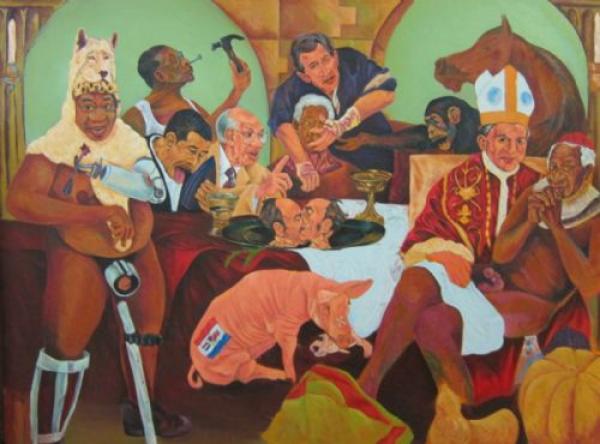Satire and the spear

Ayanda Mabula has also painted a depiction of Jacob Zuma’s penis.
First we had the Spear, a painting by Brett Murray. Now we have the Dick, a cartoon by Jonathan — Zapiro — Shapiro. And this satire of a genital nature has, in both cases, caused the same polarised reaction: support or amused indifference on one side; expressions of outrage on the other.
A comment by the National Union of Metalworkers sums up the latter: “This is nothing else, but a frontal attack on the personal integrity and social standing of the ANC President Jacob Zuma camouflaged as artistic expression.”
Repeating a common refrain among those expressing outrage, Numsa spokesperson Castro Ngobese maintained that President Zuma’s “constitutional right to dignity and respect” had, once again, been violated. But such a right is not automatic: respect has to be earned and dignity, to give a dictionary definition, is “the state or quality of being worthy of honour”.
This concept of dignity applies to individuals, not to any office or position. And individuals have to earn respect in order to be deemed worthy of honour. If any individual, especially one holding high office in society, behaves in a manner that is contrary to the norms of decency then that individual loses respect and forfeits dignity.
Highly ranking individuals, having put themselves, by their actions, in such positions, are usually expected not only to apologise to the offended public, but also to resign from positions where they are expected to be above reproach. Failure to do so or, even worse, to repeat behaviour that is widely — even generally — regarded as offensive leaves such individuals open to public criticism; to having their follies and misdemeanours held up to ridicule. To do otherwise would be to support such behaviour as acceptable.
This was the background to The Spear, the painting (styled after a poster representing the Russian revolutionary leader, Lenin) representing a leader who remains in power although being best known — and notorious — for his sexual exploits. The same applies to the latest Zapiro cartoon with a limerick referring to reports that the Spear painting issue was to be discussed at the social cohesion summit in Johannesburg last week. Whether it was or not is irrelevant; the fact that the issue remains a topic of heated debate is relevant.
It is perfectly correct to assume that the painting and cartoon are satirical representations of Jacob Zuma. He is, after all, the president of South Africa (a politically powerful man) who also happens to be notorious for having had sex with the HIV+ daughter of one friend and having fathered a child with the daughter of another (in an extended family culture, his daughters), and who has had numerous children out of wedlock while being polygamously married.
These actions are an affront to the norms of all cultures and societies in South Africa. The fact that they were committed — and repeated — by a man holding the highest office in the land, makes him a deserved target for ridicule.
And the role of satire is to hold up to ridicule behaviour that should be scorned and certainly not emulated. Having breached numerous cultural norms — across all ethnic boundaries — Jacob Zuma set himself up to have his exploits mocked. Such satire is a sign of a healthy democracy and certainly does not indicate, as a Numsa statement claims, that “some White progressives of yesteryear have become racist and colonialist in their outlook” or that they “can no longer hide their hatred for Black revolutionaries”.
A similar racial bias has been evident in several of the recent attacks on the Brett Murray painting and the Zapiro cartoon. This seems worryingly opportunistic because none of these often vitriolic condemnations has mentioned the painting by Cape Town artist Ayanda Mabulu. This painting, completed two years ago, is more graphic than The Spear, has also been published in newspapers and, in addition, raises questions about Zuma’s abuse of his own, proclaimed Zulu culture.
Perhaps the Film and Publications Board will be moved to take some action. If it does so, its members will confirm that they also continue to be a legitimate targets for ridicule. After all, the board did try to put an age restriction on The Spear and agreed that a similar restriction on works such as Michelangelo’s famous nude statue of David would be considered.
Support independent journalism
Donate using Payfast

Don't miss out on the latest news
We respect your privacy, and promise we won't spam you.
Next: Youths learn about the Constitution and the importance of activism
Previous: From Ocean View and Lavender Hill to player of the season: GroundUp interviews Ashley Hartog
© 2016 GroundUp. 
This article is licensed under a Creative Commons Attribution-NoDerivatives 4.0 International License.
